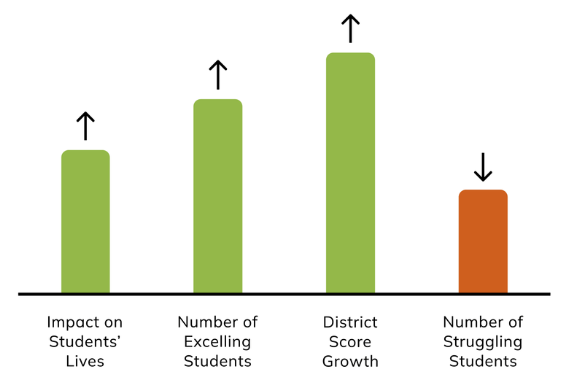Keeping students interested in learning can be a struggle for educators because it’s often difficult for learners to see any real-life relevance in the subjects. Research from the George Lucas Educational Foundation and a Bethel University research overview as well as classroom experience show that project-based learning can spark enthusiasm by exploring the real-world questions students face daily. When students engage with a curriculum that addresses real-world problems, learning becomes meaningful. Investigating and solving challenges they care about turns education into an opportunity for personal growth and community engagement.
Project-based learning grabs students’ attention by encouraging them to explore questions they wonder about, like where bubbles come from, or solve intriguing challenges, such as finding ways their city can stop polluting a local lake. A weather lesson becomes relevant when it’s connected to students’ weekend plans at the skate park. A unit on water takes on new meaning when students investigate how last year’s flash flood occurred and explore ways to prevent another from flooding Main Street, where they know the shop owners.
The power of real-world connections
Practical, real-world lessons transform abstract concepts into tangible, impactful learning experiences. These lessons give students a sense of optimism about their future and empower them to make a difference.
Lessons that connect to real-world problems increase student engagement, deepen understanding, improve academic achievement, and strengthen critical thinking skills.
Project-based learning further develops students’ communication, leadership and time management skills, essential for success beyond the classroom
This teaching approach better prepares students for life after high school as they gather research, integrate information across disciplines and delve into technology. Interacting with classroom guests who work locally on the problems that the students are studying can open their eyes to careers they never knew existed.
How to bring authenticity to the classroom

Effective project-based learning experiences typically include:
- A choice of problem that drives the student’s interest
- A connection to the community that fosters empathy
- A collaborative, solution-finding experience that’s rooted in science and builds their academic and life skills
Many school districts implement this approach with Green Ninja’s middle-school science curriculum — a structured framework that has seen widespread adoption in California schools. Each unit integrates an engaging, environmentally focused storyline to capture students’ interest while using a project-based learning approach that shows them how science connects to their everyday lives. With Green Ninja’s three-step approach, students:
- Identify a local environmental issue incorporating elements of earth, space sciences and engineering. For example, in Green Ninja’s transportation unit, students analyze infographics to compare the efficiency of various transportation methods.
- Explore scientific principles by learning the relevant, foundational concepts and using them to investigate the issue. For the transportation unit, students plan an investigation and analyze data to understand why both mass and velocity contribute to the energy associated with driving a car.
- Develop solutions by collaborating to design and implement proposals that require human action or technological innovation. To conclude the transportation unit, for instance, students might encourage their community to participate in a Junk in the Trunk Cleanup Day, where drivers are encouraged to remove extra things (i.e., mass) from their trunk so they can use less gasoline and save money.
“I think Green Ninja strikes a good balance of raising concern in students by tying concepts to real-world issues while using humor/graphics to keep the learning/activities from feeling overwhelming. Also, because each unit culminates in an action, a sense of hope remains,” Holly Rios, a sixth-grade STEM teacher, says.
Research shows the academic boost
Several studies on project-based learning have shown measurable improvements in student academic outcomes. For instance, a meta-analysis from researchers at Chongqing Normal University in China published in Frontiers in Psychology found project-based learning “positively contributed to academic achievement” and that its real value “lies in its ability to enhance students’ higher-order thinking skills, such as creative thinking skills, problem-solving skills, and integrated application skills.” Green Ninja’s data also reflects this trend, with a five-year study showing a 2.3-point increase in test scores for Green Ninja schools.
 Educators, schools and districts say their students’ achievement corroborates Green Ninja’s efficacy figure. A five-year case study analyzed eighth-grade science test scores, comparing pre-COVID data from 2019 with post-COVID results in 2022. The findings from 4,400 test scores showed a significant 2.3-point increase in scores for Green Ninja schools, while demographically similar districts saw no change. Green Ninja districts also cut the number of below-standard English language learners and low-income students by 24%.
Educators, schools and districts say their students’ achievement corroborates Green Ninja’s efficacy figure. A five-year case study analyzed eighth-grade science test scores, comparing pre-COVID data from 2019 with post-COVID results in 2022. The findings from 4,400 test scores showed a significant 2.3-point increase in scores for Green Ninja schools, while demographically similar districts saw no change. Green Ninja districts also cut the number of below-standard English language learners and low-income students by 24%.
Students surveyed five years after taking a Green Ninja course, in contrast to a comparison group, still had a strong grasp of climate science, thought more favorably about the environment and engaged in actions that led to a 30% smaller carbon footprint.
An effective classroom tool
Both robust data and anecdotal reports illustrate the many, diverse benefits of project-based learning and point to it as an engaging alternative to traditional teaching methods. Challenges that connect to students’ everyday lives, that encourage and harness empathy, and that require solutions can have lasting personal and academic effects for students.
Teachers aiming to deepen student engagement through real-world learning can turn to project-based curricula for support. Programs like Green Ninja offer a strong foundation, connecting scientific principles to meaningful, real-world contexts. Explore Green Ninja’s Effectiveness Report for the detailed case study and outcome, showcasing how real-world, project-based learning has transformed classrooms.
_________________________
Opinions expressed by SmartBrief contributors are their own.
